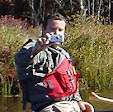 |
| Below the Alton Dam |
The Wood-Pawcatuck watershed is one of the prettiest in RI. In 2019 it became part of the National Wild and Scenic Rivers System – the only river in RI to receive this prestigious designation. Included in the Wood-Pawcatuck designation are sections of seven rivers including the Beaver, Chipuxet, Green Fall-Ashaway, Pawcatuck, Queen - Usquepaugh, Shunock, and Wood.
 |
| Heading down the Wood River |
We met at the Alton Dam at 10:00 to unload our boats and run the shuttle down to Bradford. The river was at a nice level – 200 cfs, 2.75-feet on the Wood River Junction gage. We were concerned about ice on the river, but last weekend’s rain and snowmelt raised the river about a foot and cleared out any ice. The short section of the Wood River downstream of the Alton Dam twists and turns through a pretty forest. There were a couple of blow-downs to paddle around, but we made it through fine.
 |
| On to the Pawcatuck River |
Whatever it is called, from its source at Worden Pond the river twists and turns for 34-miles to Westerly where it flows into Little Narragansett Bay. Some of the best paddling in RI is along the Pawcatuck including Great Swamp from Taylor's Landing to Biscuit City Landing, Shannock to Richmond, Richmond to Bradford, Bradford to Potter Hill, and Potter Hill to Westerly.
 |
| Running the broken dam at Burdickville |
We took a quick break to check out the "boot-leg" site located at the convergence of the Wood and Pawcatuck Rivers. We are fortunate to have a several very nice campsites on the Pawcatuck including Stoney Point on Worden Pond, the Carolina Canoe Campsite just upstream from the Richmond Landing, this "bootleg" site at the confluence of the Wood River downstream from Alton Landing, and of course, the Burlingame Canoe Campsites upstream from Bradford Landing in the Burlingame Management Area.
 |
| Enjoying the fire at the Burlingame Canoe Campsites |
The river opened up and was flowing well as we continued downstream. About a mile downstream is the broken dam at Brudickville. The dam can be portaged on the left, or run on the right. There was plenty of water flowing over the dam, so we decided to run it on the right. Everyone made it through fine. From there it is a short paddle down to the Burlingame Canoe Campsites where we stopped for lunch.
 |
| Heading down to Bradford |
From there, it is a short paddle down to Bradford Landing. We packed up our gear and sad our good-byes after another great trip.
 |
| The crew - Jeff, Chuck, Bill and Erik |
My Pictures
Wood River Junction Gage













